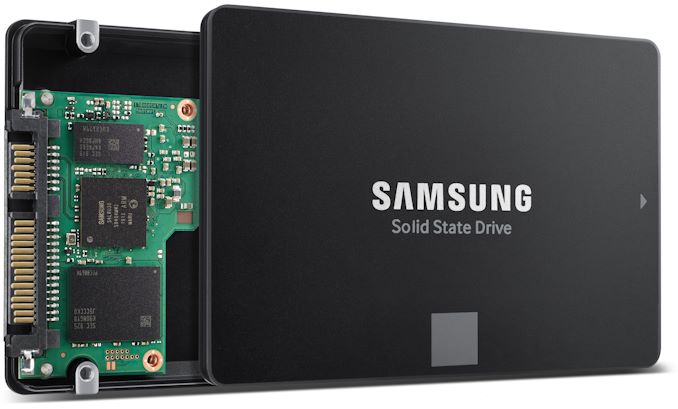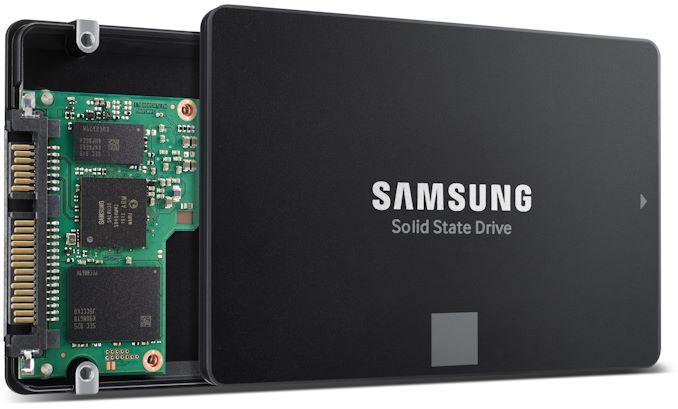Samsung Unveils 6th Generation V-NAND Memory with Up to 136 Layers
by Anton Shilov on August 6, 2019 3:30 PM EST
Samsung on Tuesday introduced its sixth-generation V-NAND memory, which in a bid to further improve capacity and density, features over 100 active layers. To make V-NAND with over 100 layers viable from performance point of view, the company had to use new circuit design technology. The new memory features 10% lower latencies and consumes 15% lower amount of power when compared to Samsung's previous-generation V-NAND.
Samsung’s 6th Generation V-NAND features up to 136 layers as well as charge trap flash (CTF) cells. The new memory uses one stack and does not use technologies like string stacking to build over 100 layers. In order to ensure minimal errors and low latencies, Samsung had to use a new speed-optimized circuit design. The latter enables the new 3D TLC 256 Gb chips to offer below 450 microseconds (μs) latency for write operations and below 45 μs for read operations, which is 10% faster when compared to 5th Generation V-NAND, according to Samsung. Meanwhile, the latest V-NAND also features lower power consumption than its predecessors.
It is noteworthy that the new 256 Gb 136-layer V-NAND devices use 670 million holes, down from 930 million holes with the previous generation, which means that the new chips need fewer process steps and are easier to manufacture. What is important is that Samsung plans to use its 136-layer architecture with speed-optimized circuit design to build V-NAND devices with over 300 layers by mounting three of the current stacks on top of each other (thus tripling a chip’s capacity).
Initially, Samsung will offer 256 Gb 3D TLC 136-layer V-NAND devices that will first be used for Samsung’s 250 GB SSDs. Later this year Samsung intends to release 512 Gb 136-layer V-NAND devices that will be used for other drives as well as eUFS storage solutions.
Speaking of the 256 GB 6th Gen V-NAND SSD, it is important to point out that it uses Samsung’s new controller marked as the S4LR030/S94G4MW2.
Related Reading:
- Samsung Shares SSD Roadmap for QLC NAND And 96-layer 3D NAND
- Samsung's New 512 GB UFS 3.0 Chip for Galaxy Fold, Now in Mass Production
- Samsung Starts Production of 1 TB eUFS 2.1 Storage for Smartphones
- The Samsung 970 EVO Plus (250GB, 1TB) NVMe SSD Review: 96-Layer 3D NAND
Source: Samsung











41 Comments
View All Comments
sing_electric - Wednesday, August 7, 2019 - link
I'm REALLY not sure that that's the case - the vast majority of cheap notebooks are purchased by people who wouldn't think of upgrading no matter what - and mid-to-high end notebooks have been SSD based for many years now (and in the past 5-ish years, many low-end notebooks like Chromebooks came with eMMC, not a HDD). On the business side, many companies that have repair contracts (which would specify a like-for-like replacement of a broken component), and the ones that don't are probably equally loathe to spend extra cash on an older machine (for a probably junior-level employee).My bet is that most 2.5" SATA drives go in desktops BY FAR, since they've got the space and a lot of SSDs come with 2.5"-3.5" adapters. If you're making a system to look decent on a spec sheet, "500GB SSD" is cheaper to do if its a 2.5" SATA drive than if its a m2 one, and if you're building a higher-end system, 2.5" drives are a great way to add secondary, slower storage (e.g. for media) while the OS and apps reside on faster, NVME storage.
Lolimaster - Monday, August 19, 2019 - link
They could a cheapo plastic filler. Fot me ssds drives should be cut in half for below 4Tb, you dont need to screw rhem anyways, case manufactures could include a pair of hole closer to each other so theyre compliant with the new sizes for people who want to secure their drives.someotheruser - Wednesday, August 7, 2019 - link
See here: https://www.anandtech.com/show/14711/toshiba-intro...austinsguitar - Tuesday, August 6, 2019 - link
i mean if they make 6 terabyte and 4 terabyte ssd's for around 200-250 dollars then we are talkin. but right now i dont see that happeningValantar - Tuesday, August 6, 2019 - link
So until technology reaches your pie-in-the-sky targets you're holding off entirely? Or are you just annoyed by technological development generally being evolutionary rather than revolutionary?azfacea - Tuesday, August 6, 2019 - link
this is a revolution. he is just b8ing duderegsEx - Tuesday, August 6, 2019 - link
Revolution is when Optane would be financially accessible.stephenbrooks - Tuesday, August 6, 2019 - link
That's my approach. I've had a 1TB HDD for 6 years. Only recently has it become economical to upgrade to a 2TB SSD, which I'll probably do with a new PC build. I wasn't going to "upgrade" to a smaller drive. Programs tend to dump their files on the Windows drive so it runs out of space fast, making having two drives quite awkward.Zhentar - Tuesday, August 6, 2019 - link
... are you seriously claiming that someone could be so hung up on the number of bytes in their storage that they'd knowingly accept the god awful miserable terrible-by-multiple-orders-of-magnitude response time of spinning rust for *six years* while simultaneously being satisfied by just one single terabyte of storage? It's just too absurd, I refuse to accept it.close - Wednesday, August 7, 2019 - link
Yeah, who knew storage devices provide more than one useful metric (capacity). If performance was you target you should have bought a "performance device". A hybrid solution (fast SSD + large HDD) is also out of the question - it's all in one or nothing. [/s]